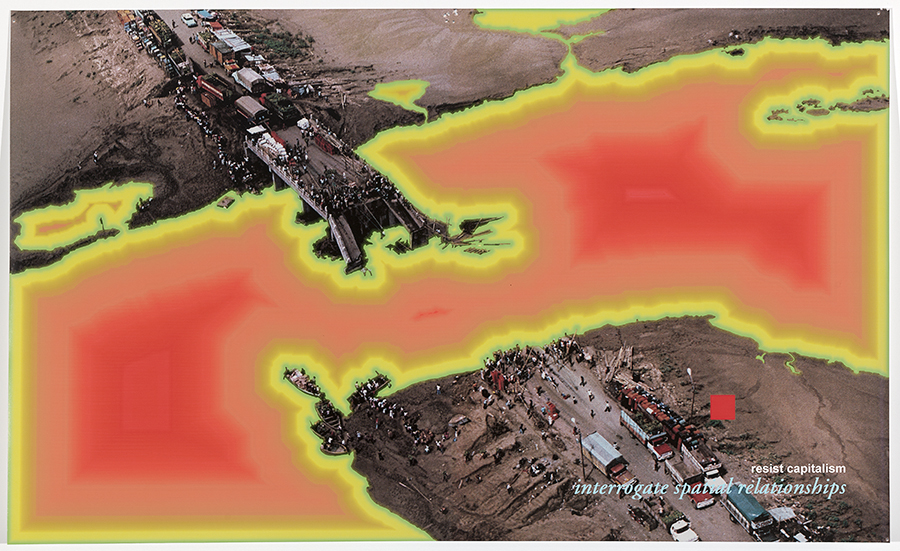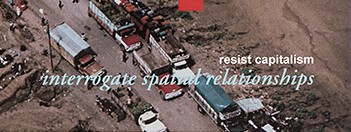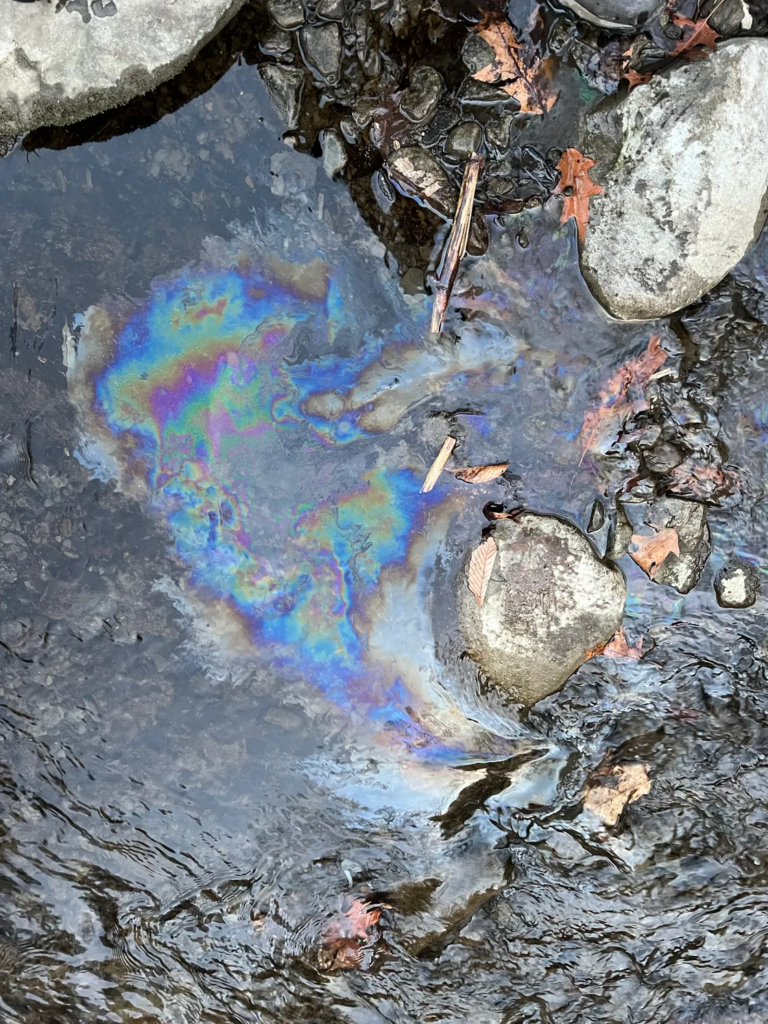
Kelley Walker, laughing, we joked that under the paving stones, there might be gold, 2001, inkjet print, 16 1/2″ x 27 1/4″.
Who is to blame for this scene?
Kelley Walker’s print work above is a digitally modified image. Originally a propaganda image, Walker uses the visual of a bridge collapse to draw attention to other forms of societal collapse. By targeting a bridge, Walker is able to play with concepts of environmental disaster, through the river, and state-sponsored infrastructure, through the repair teams.

Walker digitally modified the original photographic image to cover the river’s water with an amorphous red shape. The choice of color is alarming and unexpected, and makes it difficult to read the landscape as a river. In addition, the choice to use yellow, orange, and red, recalls the colors of a heat map, where the hottest and most dangerous zones are represented by the most vivid reds. Walker is able to play with this expectation, marking the river’s area as overheated and polluted with this color. This collapse endangered human life and the river’s health, and Walker links the collapse to the capitalist actors which influenced both the bridge’s construction and its disaster management.
Although this print was originally created in 2001, Walker’s use of a body of water as the site of a disaster remains particularly relevant. In fact, bodies of water are easily the source of many recent controversies surrounding pollution.
Take, for example, the water crisis in Flint, Michigan. In 2014, municipal officials switched the water lines supplying water into the city, resulting in lead, carcinogens, and diseases flooding into the public water supply. For several years, the entire city was at a peak crisis, relying on outside aid to supply potable water. The city, which was majority Black and had been impoverished for decades, received massive public support through social media and other organizing avenues, but little government attention to its infrastructure. It was only through major protest and sustained legal action that Flint’s water supply was improved. Nearly 9 years later, however, many residents of Flint still face major issues with the safety of public water, and continue to fight against a disinterested municipality.
How does Walker’s work recall or parallel the events of the Flint water crisis? How might its image “interrogate” both local areas and larger systems?
Other major infrastructure disasters have also occurred throughout America in the past 2 decades. The construction of oil pipelines and major roadways, necessary for maintaining car economies but increasingly destructive to the environment, have come to public attentions in controversies such as the Keystone XL pipeline proposed from Alberta, Canada to the Gulf Coast in Texas in 2017. Other issues, such as runoff from agricultural waste or the disposal of manufacturing byproducts, have become larger public questions as well.
One of the most recent nationally-recognized disasters occurred in East Palestine, Ohio, in February of 2023. A train carrying toxic and hazardous materials, such as the carcinogen vinyl chloride, derailed. In an effort to prevent an explosion, officials lit the train cars on fire, releasing massive amounts of vinyl chloride into the air and water.

One of the most distressing aftereffects of the incident was the spread of contaminants, even as the worst effects cleared. More than 43,000 aquatic animals perished due to the pollution, and air quality in the surrounding region was dangerously unsafe for several days. After the local authorities had reported that levels had declined to safe standards, however, there were still many people able to sense and smell the chemicals, and some independent testing authorities reported results that were inconsistent with the public reports. For many residents of East Palestine, the derailment wasn’t just an immediate disaster, it was a complete erosion of public trust in the railways, government reporters, and disaster responders in charge of the incident’s aftermath.
In the face of these devastating disasters, it can be easy to feel hopeless or afraid. Certainly these are difficult moments to live through and witness. But their senselessness can also inspire another emotion: anger.
When Walker urges his viewers to “reimagine spatial relationships,” he is asking the audience to disentangle their assumptions of safety and trust in corporations. Instead, he is asking the viewer to critically evaluate how these disaster sites can be products of malicious negligence, and to harness their emotional responses to fight against unjust systems that allows them to occur.